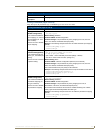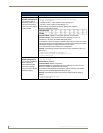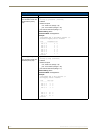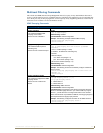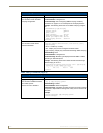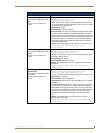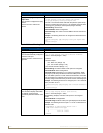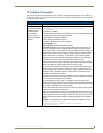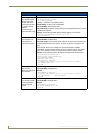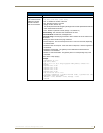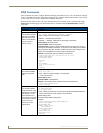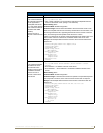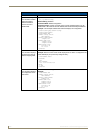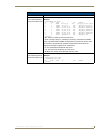
CLI (Command Line Interface)
275
NXA-ENET24 - Software Management Guide
IP Interface Commands
There are no IP addresses assigned to this switch by default. You must manually configure a new address to
manage the switch over your network. You may also need to a establish a default gateway between this device
and the management stations.
IP Interface Commands
Command Function
ip address
This command sets the
IP address for the
currently selected
VLAN interface.
Use the no form to
restore the default IP
address.
Syntax:
ip address {ip-address netmask | bootp | dhcp} [secondary]
no ip address
• ip-address - IP address
• netmask - Network mask for the associated IP subnet. This mask identifies the host
address bits used for routing to specific subnets.
• bootp - Obtains IP address from BOOTP.
• dhcp - Obtains IP address from DHCP.
• secondary - Specifies a secondary IP address.
Default Setting: DHCP
Command Mode: Interface Configuration (VLAN)
Command Usage: If this router is directly connected to end node devices (or con-
nected to end nodes via shared media) that will be assigned to a specific subnet,
then you must create a router interface for each VLAN that will support routing. The
router interface consists of an IP address and subnet mask. This interface address
defines both the network number to which the router interface is attached and the
router’s host number on that network. In other words, a router interface address
defines the network and subnetwork numbers of the segment that is connected to
that interface, and allows you to send IP packets to or from the router.
Before you configure any network interfaces on this router, you should first create a
VLAN for each unique user group, or for each network application and its associated
users. Then assign the ports associated with each of these VLANs.
You must assign an IP address to this device to gain management access over the
network. You can manually configure a specific IP address, or direct the device to
obtain an address from a BOOTP or DHCP server. Valid IP addresses consist of four
numbers, 0 to 255, separated by periods. Anything outside this format will not be
accepted by the configuration program.
An interface can have only one primary IP address, but can have many secondary IP
addresses. In other words, you will need to specify secondary addresses if more than
one IP subnet can be accessed via this interface.
If you select the bootp or dhcp option, IP is enabled but will not function until a
BOOTP or DHCP reply has been received. Requests will be broadcast periodically by
this device in an effort to learn its IP address. (BOOTP and DHCP values can include
the IP address, default gateway, and subnet mask).
You can start broadcasting BOOTP or DHCP requests by entering an ip dhcp restart
command, or by rebooting the router switch.
Only one VLAN interface can be assigned an IP address (the default is VLAN 1). This
defines the management VLAN, the only VLAN through which you can gain manage-
ment access to the switch. If you assign an IP address to any other VLAN, the new IP
address overrides the original IP address and this becomes the new management
VLAN.
Example: In the following example, the device is assigned an address in VLAN 1:
Console(config)#interface vlan 1
Console(config-if)#ip address 192.168.1.5 255.255.255.0
Console(config-if)#



